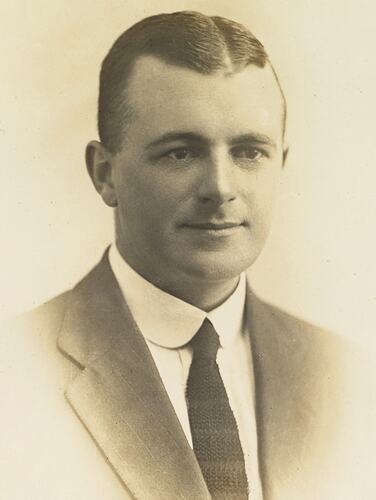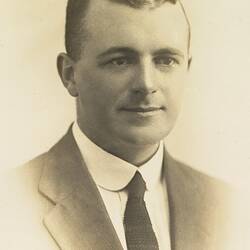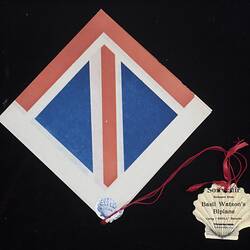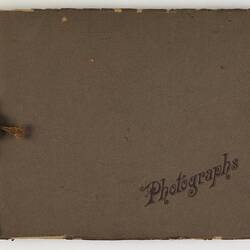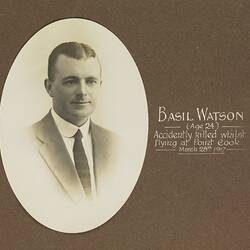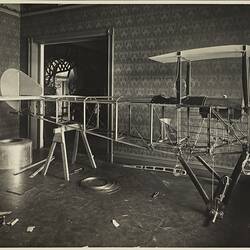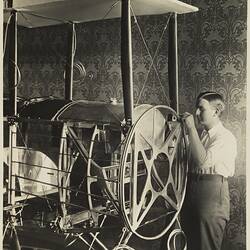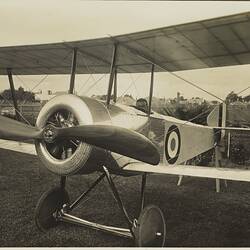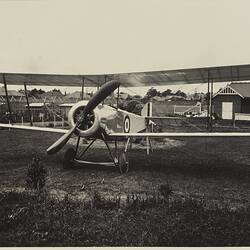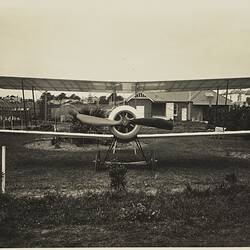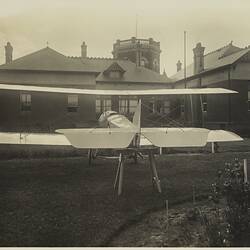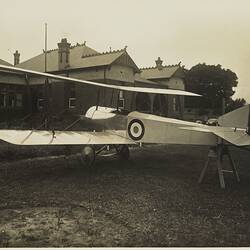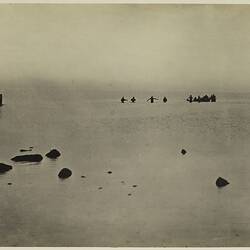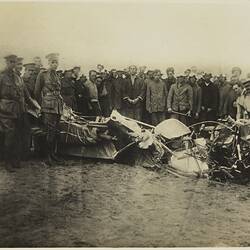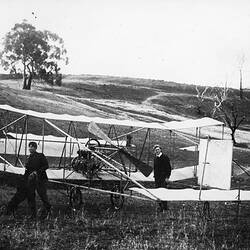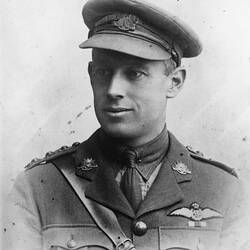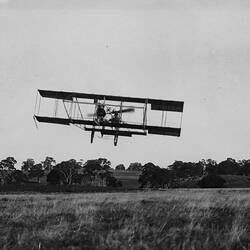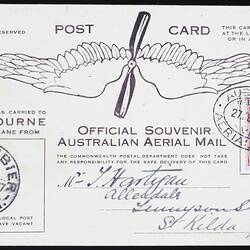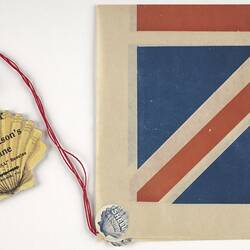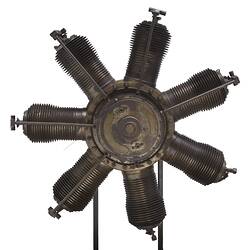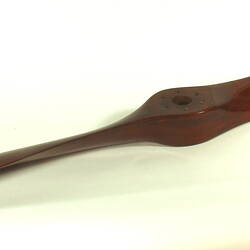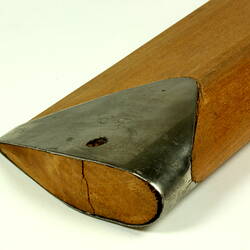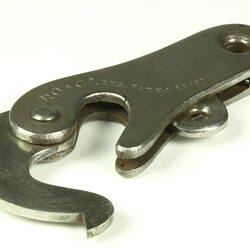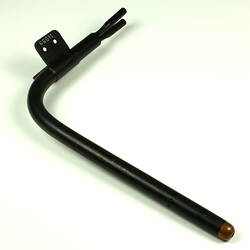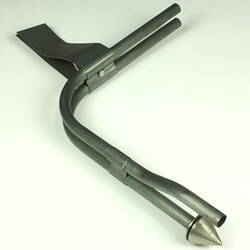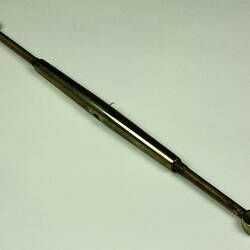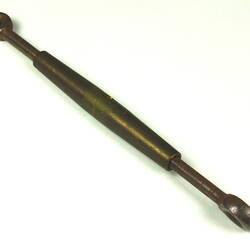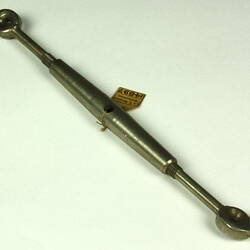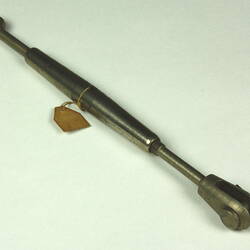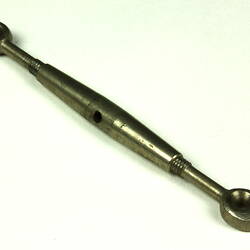Basil George Watson was born in Bendigo on 12th October 1893, being the second son of James Isaac Watson and Isabel Ada Watson (nee Knight). Other siblings included Athena Estella Knight (born 1891 - who died in infancy); Leroy Eric James (born 1892); Verona Isabel (born 1896) and James Rudyard (born 1900). Basil's paternal grandfather was John Boyd Watson, a Scottish-born cabinetmaker, who was one of Bendigo's early 'quartz kings', making a fortune from his role in pioneering the extraction of gold from quartz reefs. Later J.B. Watson invested heavily in real estate, banking, transport enterprises and pastoral interests holding assets that swelled extraordinarily in value during the heady 'land boom' decade of the 1880s. When he died in 1889, his estate was valued at over £1 million, leaving James Watson and other descendants comfortably well off.
In 1894, Basil Watson's family moved from Bendigo to Melbourne, where they settled in the Brighton area and Basil with his brothers attended Haileybury College, a small private school established by Charles Rendall only two years earlier. In 1909, the family moved into a grand purpose-built ten-roomed Federation style mansion named 'Foilacleugh', situated on several acres fronting onto Port Phillip Bay at Elsternwick. The extensive grounds included neatly groomed lawns and garden beds, a lawn tennis court, nine hole golf putting course, boathouse and slipway, motor garage and workshop. James Watson pursued interests in motoring, motor yachts and horse racing, and it seems that the whole family took an early interest in aviation. When the world-famous escapologist Harry Houdini became the first person in Australia to successfully complete an extended flight of 7½ minutes duration at Diggers Rest, in March 1910, Basil parents and sister were amongst the crowd of 30 spectators there to witness the event. Their names were included in a list of 16 signatures on a certificate verifying the achievement.
After leaving school, young Basil Watson spent a period managing a pastoral property in country New South Wales and undertook some training as a mechanic in Melbourne, before turning his full attention to aviation. Harry Hawker, Australia's best known pioneering aviator and founder of the Hawker-DeHavilland aviation and aerospace company, had grown up in Moorabbin and St Kilda and was known to Basil Watson through a friendship between the two families. Hawker had left Australia in 1911 for England, where he gained employment as a mechanic with the Sopwith Aviation Co, and was personally taught to fly by the company's founder Thomas Sopwith. Over the following two years Hawker set several aviation records in England and almost claimed the Daily Mail prize of £5000 offered for the first person to successfully fly around Great Britain. By 1913 he had been promoted to a role as aircraft designer and chief test pilot with Sopwith. In early 1914, Hawker returned to Australia with a small Sopwith biplane of his own design and made headlines in the local press presenting public flying demonstrations in Melbourne, Sydney, Albury and Ballarat. During the tour he carried several notable citizens as passengers, including the Governor-General and Minister of Defence. It was at Elsternwick Golf Course on Wednesday 11th February 1914, the Basil Watson first took to the air as a passenger in Hawker's biplane. He had been scheduled to make his first flight the previous Saturday at Caulfield Racecourse, but a large crowd of several thousand spectators made it too dangerous to safely take-off and land the plane. Hawker was five years older than Basil Watson and took the young engineer under his wing as a protégé. Watson subsequently accompanied Hawker on trips to Albury and Ballarat where further flying demonstrations were made, and when Hawker left Australia to return to England, he was accompanied by Watson, who was described as his 'pupil'. The pair sailed from Melbourne on the P&O Line steamer R.M.S. Mooltan, on 5th May 1914 - Basil Waston was just 20 years of age.
Hawker arranged for Watson to join the Sopwith Aviation Company as an engineer, being initially trained in the details of aircraft design and construction, while also undertaking flying lessons. With the outbreak of World War I, people with any aviation experience were soon in keen demand and the Sopwith Company was awarded several major military contracts. Within 12 months Watson had been promoted to works foreman with Sopwith and was seconded as a test pilot to the Imperial Army being based at Brooklands airfield, where he undertook trial flights of new aircraft. On a fateful test flight on 22nd June 1915, Watson took off from Brooklands piloting a new Sopwith aircraft powered by a 150 h.p,. Sunbeam V-8 engine. He had barely cleared the airfield climbing to just 150 ft when four cylinders suddenly failed, causing the engine to seize and the plane began rapidly descending. With no time to turn the plane around and return to the airfield, Watson narrowly avoided a house and steered for gap in the heavy tree cover, but collided with a tree trunk at 90 miles per hour. He was fortunate to escape with a nasty gash on his head, a few cuts and bruises and a severe case of concussion. Although he would fully recover after several month convalescence, Watson was ruled medically unfit for further service, bringing to a premature end his hopes of an extended military aviation career. Before returning to Australia, Watson gained his civilian pilot's licence in October 1915. His older brother, Eric Watson, had followed Basil to England in July 1915, and after training, joined the Royal Flying Corps as a Flight Lieutenant in 1917.
Arriving back in Hobart on the SS Athenic in the first week of June 1916, Basil Watson was interviewed at length by a reporter from the Mercury, and the extend article recounting his flying experiences was widely republished by other Australian newspapers. Within a fortnight of reaching Melbourne, Watson had begun the construction of his own biplane at his parent's house 'Foilacleugh', in Elsternwick. Although Watson told the Mercury reporter that he had ordered a plane from the Sopwith Company, it appears that the plane never arrived - perhaps due to the pressure of other more urgent wartime orders. He purchased a second-hand French-built Gnome 7-cylinder rotary engine that had originally been imported into Victoria in 1911, and began building the frame of the fuselage and wings in the billiard and living rooms of the family home, using seasoned bass and mountain ash timber sourced from Tasmania. The propeller was fashioned from Queensland walnut by James Moore & Sons, of City Road, South Melbourne. It appears that Watson had some assistance from Arthur Dowdall, an engineer, and possibly some other local mechanics, while some of the metal components were probably obtained through Melbourne engineering companies. Sections were moved outside onto the extensive lawns surrounding 'Foilacleugh' for final assembly and covering of the frame and wings with 'doped' silk fabric to obtain taut streamlined surfaces.
The aircraft was completed on Saturday 28th October 1916, after just three months of work and was conveyed to the military aviation school at Point Cook, for initial flight testing. The following Monday the aircraft was given its first public trial in front of a group of spectators at Point Cook, with Watson staying aloft for 45 minutes and at one stage reaching a height of 5,000 feet (1,500 metres). A reporter from the Herald described the demonstration as "a thrilling spectacle". At the end of November 1916, Watson flew his plane from Point Cook to Bendigo, in the first long-distance overland flight undertaken in Victoria, landing landed at the Epsom Racecourse after a flight of just 80 minutes. A fortnight later he presented a public exhibition of 'thrilling aerial evolutions' flying from the racecourse. Returning from Bendigo on 15th December, Watson had the unnerving experience of flying into heavy cloud with limited visibility. Becoming 'lost' he circled Melbourne for three-quarters of an hour at a the height of 8,000 ft (2,400 m), before descending blind through the cloud, re-emerging at 1,200 feet (360 m) over Flemington Racecourse, where he was able to reset his bearings and head for the landing ground at Point Cook. Shortly afterwards Watson announced plans in the media to attempt a non-stop flight from Melbourne to Sydney early in the New Year, hoping achieve a record for the longest non-stop flight in Australia.
Before plans for the Sydney flight were completed, Basil Watson departed Melbourne on 24th January 1917, on the initial leg of Australia's first 'barnstorming' aviation tour, promoted by the entrepreneurs Albert Sculthorpe and R. Sissons. During the trip, which lasted over a month, Watson visited Warrnambool, Hamilton and Mount Gambier, before returning via stopovers at Casterton, Hamilton, Warrnambool and Camperdown. At each town he presented a public flying demonstration for crowds of spectators, featuring his usual aerobatic displays with feats such 'looping the loop', upside down flying, somersaulting and 'perpendicular nose dives', generating much amazement and admiration. The promoters had received approval from the Postmaster General's Department to carry an experimental airmail consignment on the return journey from Mount Gambier, and Watson landed in Albert Park on his arrival back in Melbourne on 27th February, carrying over 1,000 pieces of airmail collected from each of the towns on route. Much of the mail was in the form of official souvenir postcards commemorating the event, which were reposted on arrival to local addresses in Melbourne. The Museum holds two examples of this early form of aviation advertising.
Watson was booked to present a flying demonstration on Thursday 29th March 1917 at Caulfield Racecourse, as part of a fund raising carnival for the Red Cross. Flushed with public enthusiasm from his recent county tours, the promoters advertised the event during the lead up in the Melbourne daily papers, describing Watson as 'The Wizard of the Void', 'The Athlete of the Sky' and 'The Magician of the Air'. In order to prepare for the event, Watson had his plane transported back to the family home at Elsternwick, where it was given a thorough mechanical overhaul and the wings were recovered with new fabric to repair damage sustained at Mount Gambier. The day before the event on 28th March, Watson arranged to make a test flight from Albert Park to Point Cook, were he could leave the plane in one of the hangars overnight. Arriving over Point Cook around 3:40 pm Watson proceeded to entertain soldiers stationed at an adjoining A.I.F. camp with a display of his typical aerobatic feats. Having successfully completed a 'loop the loop', he banked the plane to enter a steep dive at 2000 ft (600 m), when suddenly a small clip securing part of the aircraft gave way and the wings appeared to fold back on themselves, causing the aircraft to plummet headlong towards the ground. Watson could be seen desperately trying to regain control, before realising that all hope was lost, and instead steering the plane away from the crowd of thousands of spectators. The aircraft plunged into the sea almost nose first, crumpling on impact in less than a metre of water close to the shoreline. Basil Watson was severely injured and died moments later as the first witnesses arrived on the scene wadding out to the wreckage.
The tragedy deeply affected the extended Watson family and many of the public who had eagerly read news of his triumphs in the daily press over preceding months, applauding his daring feats. It as a sign of the public impact of the accident, that a crowd of 7,000 lined the streets to watch his funeral procession passing and thousands more waited near the graveside at Boroondara Cemetery to pay final homage. The family received over 600 letters and telegrams of sympathy and officers from the Point Cook Flying School formed a guard of honour as coffin bearers.
It is ironic that only four years later Harry Hawker, Watson's former flying mentor, was also tragically killed by an aircraft crash in England, and thus Australia lost two of its most famous aviation pioneers.
References:
Parnell, N. & Bouighton, T., Flypast: A Record of Australian Aviation, Australian Government Publishing Service, Canberra, 1988.
Winter, Carole, Basil Watson - Pioneer Aviator, Penfolk Publishing, Blackburn, Victoria, 2015.
'Aviator's Plan's. Hawker Returning To Europe. Flying School In Melbourne.', Argus (Melbourne, Vic.), Friday 1 May 1914, p.10, http://nla.gov.au/nla.news-article7268546.
'About People', Bendigo Independent (Vic.), Tuesday 7 April 1914, p.5, http://nla.gov.au/nla.news-article226851276.
Donald Macdonald, 'Aviation - Early Flying In Melbourne', Winner (Melbourne, Vic.), Wednesday 5 August 1914, p.16, http://nla.gov.au/nla.news-article155527646.
'The War Aloft. Experiences of Australian Aviator. The Latest Machines', Mercury (Hobart, Tas.), Friday 2 June 1916, p.2, http://nla.gov.au/nla.news-article1023033
'Air Service. Work Over The Firing Lines. Victorian Aviator.', Sydney Morning Herald (NSW), Friday 2 June 1916, p.10, http://nla.gov.au/nla.news-article15667795.
'Bendigo Aviator's Experience.Thrilling Aerial Disaster.', Bendigo Advertiser (Vic.), Wednesday 7 June 1916, p.7, http://nla.gov.au/nla.news-article89980228.
'Homebuilt Aeroplane Australian Loops-The-Loop', Sun (Sydney, NSW), Sunday 5 November 1916, p.4, http://nla.gov.au/nla.news-article223375119.
'Aerial Achievements. Bendigo Boy's Successful Flight', Bendigo Independent (Vic.), Thursday 30 November 1916, p.6, http://nla.gov.au/nla.news-article219806780.
'Air Journey to Bendigo. Mr. Basil Watson's Flight.', Argus (Melbourne, Vic.), Thursday 30 November 1916, p.8, http://nla.gov.au/nla.news-article1600245.
'Flies From Melbourne.Bendigo Aviator Lands, At Epsom Racecourse.', Bendigonian (Bendigo, Vic.) 7 December 1916, p.27, http://nla.gov.au/nla.news-page8552465.
'Bendigo's Skilful Aviator. Mr. Basil Watson. Fine Flight To Point Cook.', Bendigonian (Bendigo, Vic.), Thursday 21 December 1916, p.5, http://nla.gov.au/nla.news-article91382031.
'Aviation Tragedy. Basil Watson Killed.', Albury Banner & Wodonga Express (NSW), Friday 30 March 1917, p.4, http://nla.gov.au/nla.news-article99865917.
'Funeral of Mr. Basil Watson.', Age (Melbourne, Vic.), Monday 2 April 1917, p.8, http://nla.gov.au/nla.news-article154974678.
More Information
-
Keywords
-
Localities
Bendigo, Victoria, Australia, St Kilda, Victoria, Australia, Elsternwick, Victoria, Australia, Point Cook, Victoria, Australia, Mt Gambier, South Australia, Australia
-
Authors
-
Article types
